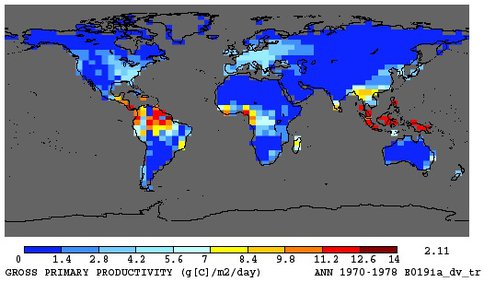2010 Annual Science Report
 VPL at University of Washington
Reporting | SEP 2009 – AUG 2010
VPL at University of Washington
Reporting | SEP 2009 – AUG 2010
The VPL Life Modules
Project Summary
The Life Modules of the VPL are concerned with the modeling of biosphere processes for coupling with the VPL’s atmospheric and planetary models. These coupled models enable simulation of the impact of biogenic gases on atmospheric composition, of biota on the surface energy balance, and of the detectability of these in planetary spectra. The Life Modules team has engaged in previous work coupling 1D models in the VPL’s suite of planetary models, and current work now focuses on biosphere models coupled to 3D general circulation models (GCMs). Current project areas are: 1) development of a model of land-based ecosystem dynamics suitable for coupling with GCMs and generalizable for alternative planetary parameters, and 2) coupling of an ocean biogeochemistry model to GCMs.
Project Progress
Ent Dynamic Global Terrestrial Ecosystem Model (Ent DGTEM) (Kiang, collaborators at NASA GISS, NASA GSFC, CUNY Hunter College). Last year we tested global off-line simulations of Earth seasonal vegetation dynamics, forced with observed meteorology, showing reasonable predictions of leaf area. This year, we implemented a full carbon cycle in the Goddard Institute for Space Studies (GISS) GCM, in collaboration with Anastasia Romanou at GISS, who implemented the ocean biogeochemistry model of VPL Co-I Gregg into the ocean model of the GISS GCM. We are continuing evaluation and testing of the coupled carbon dynamics to achieve a balanced carbon cycle. In collaboration with Dr. Wenge Ni-Meister at the City University of New York, Hunter College, and her funding from the ICESat/GLAS program, the interim land cover dataset of the previous year is now being upgraded to utilize the latest MODIS products (land cover, leaf area index, albedo), as well as LiDAR of ICESat/GLAS (vegetation height) to serve as both boundary conditions or as a performance evaluation dataset. Two papers were published on the Ent model’s canopy radiative transfer scheme for mixed canopies and clumped foliage.
NASA Ocean Biogeochemical Model (NOBM) (Gregg, collaborators at NASA GISS, NASA GSFC). The NOBM is a model previously developed at NASA GSFC that is now being integrated within two modeling systems: the GISS Model E and GMAO GEOS-5 Earth system models. NOBM has been successfully integrated into GISS Model E and has been applied for post-industrial carbon cycling. A paper is being drafted to be submitted to Ocean Modelling. Efforts to integrate into GEOS-5 are continuing, and the model has been partially integrated under the protocols of the Earth System Modeling Framework.
Life most likely formed first underwater on the Early Earth, since water serves as a solvent as well as providing protection again UV radiation. The ocean biogeochemistry module will afford simulation of such phenomena as sulfur cycling and iron-utilizing anoxygenic photosynthesis on the Early Earth, the stratification of dominant photosynthetic pigments by light quality, and potential variations in the 50% of net primary productivity of life on the modern Earth. Using an earlier OGCM, NOBM was applied to questions relating to early life on Earth in an effort to understand possible scenarios on other planets. A global experiment was conducted using cyanobacteria as the only photosynthetic group in the oceans (i.e., modern diatoms, chlorophytes, and coccolithophores were removed from the standard NOBM configuration). They were consumed by primitive heterotrophic bacteria. There was no iron limitation assuming that volcanic sources of iron were abundant. Also the atmospheric carbon partial pressure was assumed to be 1000 uatm.
The analyses showed that the early Earth ocean had 19% less primary production and 35% more nitrate due to slower growth by the cyanobacteria, and reduced nutrient uptake efficiency relative to modern phytoplankton. Silica concentrations were of course much higher than the modern Earth since cyanobacteria do not uptake silica. Additionally there was 8% more total carbon in the oceans as a result of higher atmospheric pCO2.
Average annual gross primary productivity (GPP) for 10 years after 20-year spin-up, from Ent DGTEM coupled to the GISS GCM, late 20th c. climate. Global annual GPP of 100 PgC/yr is within estimated observed range. Lower LAI and evapotranspiration than from AVHRR derived observations maybe to due GCM climate biases and prescribed vegetation cover not in equilibrium with the GCM climate.
Publications
-
Ni-Meister, W., Yang, W., & Kiang, N. Y. (2010). A clumped-foliage canopy radiative transfer model for a global dynamic terrestrial ecosystem model. I: Theory. Agricultural and Forest Meteorology, 150(7-8), 881–894. doi:10.1016/j.agrformet.2010.02.009
-
Yang, W., Ni-Meister, W., Kiang, N. Y., Moorcroft, P. R., Strahler, A. H., & Oliphant, A. (2010). A clumped-foliage canopy radiative transfer model for a Global Dynamic Terrestrial Ecosystem Model II: Comparison to measurements. Agricultural and Forest Meteorology, 150(7-8), 895–907. doi:10.1016/j.agrformet.2010.02.008
- Kiang, N.Y., Aleinov, I., Ni-Meister, W., Moorcroft, P.R. & Koster, R. (2010). Coupled Dynamic Global Vegetation Models (DGVMs) for Climate Simulations and Data to Constrain Them [Public Talk September 16, 2010]. Science Visitor and Colloquium Program – Earth Science Seminar Series.
- Kiang, N.Y., Mielke, S., Mauzerall, D., Blankenship, R.E. & Gunner, M. (2009). Efficiency of photon energy use for life processes: implications for spectral biosignatures [Public Talk November 10-13, 2009]. Innovative Approaches to Exoplanet Spectra Workshop.
- Kiang, N.Y., Mielke, S., Mauzerall, D., Blankenship, R.E. & Gunner, M. (2009). Efficiency of photon energy use for life processes: implications for spectral biosignatures [Public Talk November 19, 2009]. Center for Exoplanet Science Colloquium.
- Kiang, N.Y., Yang, W.Z., Ni-Meister, W., Moorcroft, P.R. & Aleinov, I. (2009). Vegetation community structure in a mixed-canopy dynamic global terrestrial ecosystem model: sensitivity of biosphere-atmosphere exchange to canopy vertical stratification and demography [Public Talk December 13-17, 2009]. American Geophysical Union, Fall Meeting.
-
PROJECT INVESTIGATORS:
-
PROJECT MEMBERS:
Wenge Ni-Meister
Co-Investigator
-
RELATED OBJECTIVES:
Objective 1.2
Indirect and direct astronomical observations of extrasolar habitable planets.
Objective 6.1
Effects of environmental changes on microbial ecosystems
Objective 6.2
Adaptation and evolution of life beyond Earth
Objective 7.2
Biosignatures to be sought in nearby planetary systems

